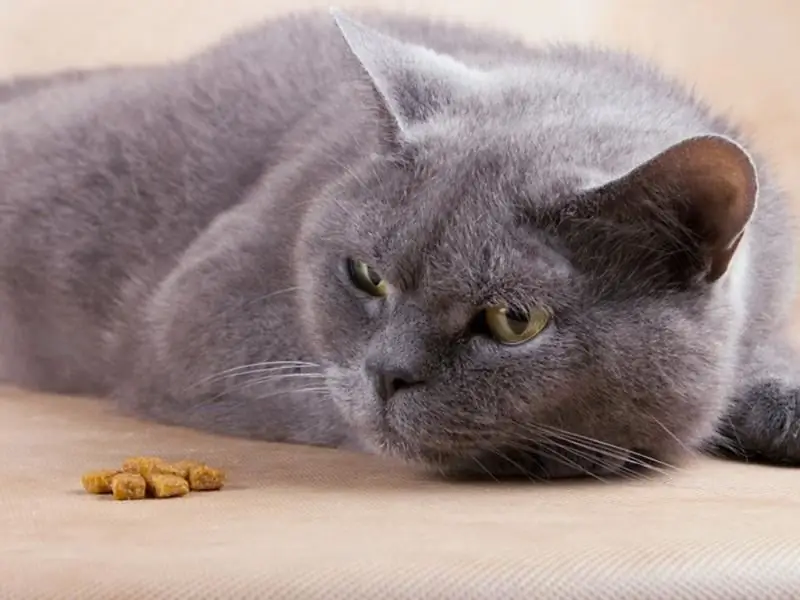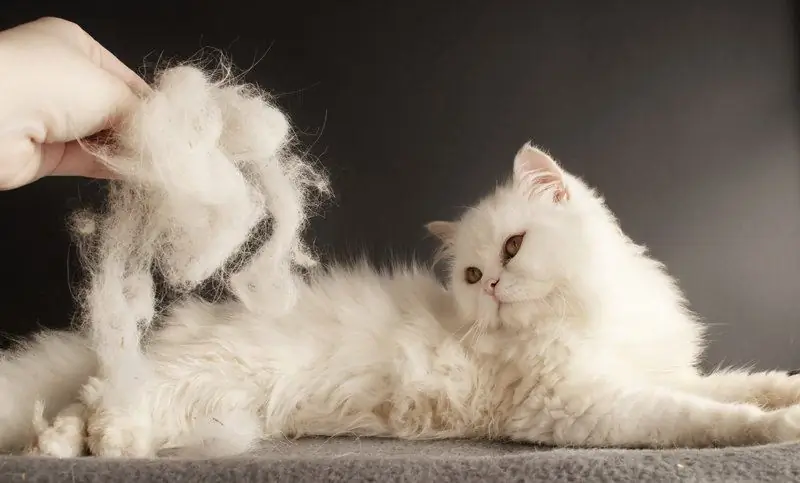
Table of contents:
- Author Bailey Albertson [email protected].
- Public 2023-12-17 12:53.
- Last modified 2025-06-01 07:32.
The cat refuses water and food

Refusal of food and water for several days is a dangerous symptom, which in most cases indicates the presence of diseases of the internal organs. The greatest threat is posed by violation of the drinking regime. If an adult animal can go without food for 2-4 weeks, then in the absence of water, dehydration and death quickly occur.
Content
- 1 What is anorexia
- 2 Signs of anorexia in cats
-
3 Should I go to the veterinarian
- 3.1 Physiological norm
- 3.2 Dangerous condition
-
4 Diseases that are accompanied by refusal of food and water
4.1 Table: Diseases causing food and water refusal
- 5 Diagnostics
- 6 How to deal with dehydration
- 7 Ways to Improve Appetite
- 8 Prevention
- 9 Expert opinion
What is anorexia
Anorexia in cats is a syndrome characterized by a complete lack of appetite. The condition usually refers to mental disorders, since hunger is a physiological instinct, while desire is a psychological stimulus. Anorexia in most cases is associated with diseases of the internal systems and organs. It is extremely rare that the disease is recognized as idiopathic.
It is important to distinguish between anorexia and pseudoanorexia in the diagnosis and treatment regimen. The first is associated with a complete lack of appetite. With pseudo-anorexia, the cat wants to but cannot eat due to pain or mental disturbances. This form develops, for example, with diseases of the oral cavity.
Signs of anorexia in cats
The key signs of anorexia are food refusal and rapid weight loss. With the true form of the disease, the animal completely loses interest in food and turns away from the bowl. With pseudo-anorexia, the cat sniffs the food and can even taste it, but later spits out the pieces and just leaves.

To understand if an animal is suffering from severe malnutrition, it is necessary to pay attention to the ribs, hips, shoulder blades and thoracic region: with significant weight loss, the bones bulge
With the addition of dehydration, the animal becomes less active. With a mild degree, it can look like fatigue after games. Later, the animal becomes passive and does not make contact.
Depending on the cause of anorexia, the syndrome may be accompanied by other symptoms. For example, with intestinal infections, diarrhea appears, and with damage to internal organs, swelling and bleeding.
Should I go to the vet
It is impossible to give an unambiguous answer to this question. The owner should independently assess the condition of the pet and determine the appropriateness of treatment. If the refusal of food is partial, and the cat turns away from the food, but eats favorite treats, it is recommended to postpone the assistance. Perhaps it is a matter of selectivity, which arises for various reasons: from stress and bad mood to sexual desire.
Physiological norm
Partial or short-term complete refusal of food may be the norm in the following cases:
- Recently received treatment or surgery. Aggressive medications can cause temporary (up to 2-3 days) weakness. Often this happens after taking antibiotics, since they destroy the local microflora. To mitigate their action and accelerate recovery, pro- and prebiotics can be used.
- Vaccination was recently postponed. Most preparations contain weakened, but live pathogens, to which the cat's body independently develops immunity. This requires the mobilization of all internal resources, which causes partial or complete loss of appetite. Interest in water continues. Normally, a cat can refuse food for 1-2 days.
- The cat has a fasting day. Some animals voluntarily refuse food every 2-3 months for up to 2 days. It is assumed that this is done instinctively to normalize the digestive tract.
- The cat is pregnant or feeding kittens. Voluntary fasting can be associated with the imminent onset of childbirth or banal fatigue after the birth of babies. The cat drinks water, but eats poorly for 1-2 days.
- The animal is in heat. During sexual hunting, the reproductive instinct becomes the main one, therefore, throughout the entire period, the cat can eat poorly and lose weight.
Refusal of food associated with a runny nose in case of colds does not need urgent correction. Subject to adequate therapy for primary pathology, the nutritional schedule will gradually normalize. The same goes for hunger along with discomfort unrelated to disease. For example, a cat may starve due to stress after moving.
Dangerous condition
Threats include refusing water for 12 hours or more, as well as complete fasting for more than 3 days. Dehydration is more dangerous than exhaustion and occurs more rapidly, therefore it is important to be able to correctly assess the pet's well-being. This can be done using the following methods:
-
Checking the gums. It is necessary to quickly move the lip and examine the mucous membranes. They are normally moist and shiny. When dehydrated, the body conserves moisture, so it dries out. An additional symptom is a feeling of gum stickiness. Drying out occurs with moderate to severe dehydration. In such cases, urgent intervention is required. It is important to quickly assess the condition of the cat, since moisture evaporates quickly upon contact with air, which makes diagnosis difficult.

Healthy gums Normally, the gums should be pink.
-
Pulling back the skin. Gently pinch the withers or skin. The second is preferable, since the skin at the withers is thicker and recovers more slowly, but this option is better suited to owners of aggressive animals. After releasing the fold, it should instantly smooth out. A slight delay may indicate mild dehydration. The danger is the slow smoothing of the skin or maintaining the previous position.

Pulling the skin at the withers The grip and pull should be felt, but not painful.
- Capillary filling rate measurement. With dehydration, blood volume decreases, it becomes more viscous, so its circulation slows down. To check, you need to lightly press on the animal's gum, then release it and calculate the time until the color normalizes. The norm is 1-2 seconds. Delay appears with severe dehydration, which requires urgent intervention. Gum blanching is most dangerous even at rest.
To indirectly confirm the diagnosis, you can feel the paw pads of the animal. They will be cold when dehydrated. In the absence of other signs, a low temperature alone does not indicate a deviation.
You should contact your veterinarian if you have any other specific symptoms: vomiting, weakness, redness of the gums, etc. Additionally, a visit to the clinic is mandatory if the animal is extremely exhausted.
If the kitten has lost its appetite, the possible fasting time is reduced to 4-12 hours, depending on the age. If a six-month-old animal can maintain normal health while refusing food and water for 12 hours, then a newborn baby dehydrates rapidly. Sometimes only 4-6 hours is enough for death or irreversible changes.
Diseases that are accompanied by refusal of food and water
Almost any pathology can cause partial or complete refusal of food and water. This most often occurs during exacerbation and concomitant development of complications.
Pseudoanorexia often develops against the background of the following diseases:
-
Gingivitis, stomatitis and other pathologies of the oral cavity. In such cases, the cat wants to eat, but feels pain in the process, so it refrains from eating. Visual examination reveals reddening of the gums, calculi, ulcers, bleeding and other defects. To relieve pain on its own, the cat may begin to chew on hard objects. Thus, the animal tries to remove the problem tooth.

Redness of the gums Pink border near the teeth is a characteristic symptom of gum disease
- Neoplasms in the tongue, tonsils, or mouth. The tumors are uncomfortable and may bleed. The main symptom of disease is the presence of a neoplasm. It can be hard or soft, pink, white or black, depending on the type of pathology.
-
Injuries and pathologies of the musculoskeletal system. In this case, refusing food and water is associated with limited mobility. The cat becomes lethargic and inactive, moves little, limps, pulls its hind legs with it, etc.

Kitten pulls its hind legs With injuries and some diseases of the spine, the gait of the animal changes greatly, the most common is the failure of the hind legs
With pseudoanorexia, in all cases, appetite is not additionally corrected. This is not necessary, since the desire for pets remains. In rare cases, with prolonged progression of the disease, negative associations are fixed, but usually cats return to their normal diet within 2-3 weeks.
Real anorexia can occur in many diseases: inflammatory, infectious, autoimmune, etc. We will point out the most common causes.
Table: Diseases causing food and water refusal
| Disease or condition | Typical symptoms | Need for treatment of concomitant appetite disorders |
| Internal injuries | Internal bleeding, blood in the stool (if the gastrointestinal tract is damaged), swelling and severe pain | Additional correction is not required, since this is an acute condition. The animal does not have time to lose much weight. Negative associations are not fixed |
| Intoxication | Nausea, vomiting, drooling, indigestion | In most cases, it is enough to remove intoxication, but in case of a serious condition, intravenous fluids are given and switch to tube feeding. |
| Lipidosis (accumulation of fat in the liver) | Lack of appetite for several weeks, rapid weight loss, diarrhea or constipation, vomiting, jaundice | Appetite correction is mandatory. Many cats are malnourished and are offered a high-calorie, high-protein meal. They try to feed in a familiar environment, exclude stress factors. Correction is carried out until the animal begins to feed normally on its own. Probe can be used |
| Infectious diseases | Symptoms depend on the location of the pathology. Common signs include fever, weakness, and pain. | In most cases, additional correction is not required, since this is an acute condition. After a short-term hunger strike and elimination of pathology, appetite normalizes on its own |
| Diseases of the digestive tract | Symptoms differ depending on the organ affected. If the functions of the pancreas are impaired, the digestibility of fats is impaired, diarrhea is observed. With gastritis, the body temperature sometimes rises. In most diseases of the gastrointestinal tract, the cat's gait changes: it hunches down due to pain | The need for additional correction depends on the condition of the animal. If the pet does not eat well even after the normalization of the condition and has managed to lose weight greatly, a decision is made to change the diet. High-calorie, gentle foods can be used. For example, baby puree |
| Helminthiasis | With a strong infection, worms are found in vomit and feces. The cat can lose weight even with increased appetite. At some point, the animal refuses food due to a general deterioration of the condition or intestinal obstruction | Discussed with the veterinarian. In the absence of significant weight loss and short-term loss of appetite, the condition is not corrected. After the use of anthelmintic drugs, in the absence of complications, the appetite is normalized without outside intervention |
| Any severe inflammation | Symptoms depend on the type of disease. Often, the animal's appetite disappears due to pain during exacerbations of chronic pathologies | Depends on the condition of the animal. With a prolonged and severe course of pathology, a pet during periods of remission may be offered more high-calorie food to restore a normal physique |
| Visual and olfactory disorders | Loss of orientation in space. Smell disorders are detected through tests | In most cases, animals do not need a strong correction. After therapy, the diet is normalized. If it is impossible to treat the disease, owners are advised to use additional ways to improve appetite |
| Intestinal obstruction | Severe pain, vomiting, bloating. The abdomen is firm. With partial obstruction, diarrhea is observed, with complete obstruction, constipation and lack of gas formation | With a timely appeal to the veterinarian, additional measures are not taken, since the animal does not have time to lose weight much |
Please note that these are only general guidelines. In each case, the veterinarian makes a decision individually, based on the condition of the pet. Even mild intoxication or taking antibiotics can cause severe exhaustion in the absence of adequate care. It also happens the other way around: with timely treatment and competent maintenance therapy for gastrointestinal diseases, animals in most cases do not need separate treatment for anorexia. If the pet has severe symptoms of dehydration or exhaustion, correction is necessary to prevent the onset of a critical condition.
Diagnostics
To determine the reason for refusing food and water, anamnesis is first taken. It is advisable to try to independently determine whether the animal is hungry or not at all hungry. It is important for the owner to note the moment of the behavior change. Every little thing matters. It is necessary to inform the veterinarian about what the animal has previously eaten. Attention should be paid to new uncharacteristic habits. For example, one day a colleague of mine started complaining that her cat started chewing on shoes. Several months passed. She said that the cat began to eat less and became thinner. At first, I did not connect these 2 facts, but then, during a preventive examination, the animal found helminths and tartar.

If the cat is severely exhausted and dehydrated, first aid is given and symptomatic treatment is carried out even before the diagnosis is made.
After interviewing and examining the pet, blood and urine are taken for analysis. The results help detect diseases of the genitourinary system or gastrointestinal tract, as well as confirm the presence of an inflammatory process. With dehydration, the number of erythrocytes increases (more than 10). It is advisable to donate feces for analysis to detect helminth eggs and protozoa. If the cause cannot be identified, a PCR study is performed. It helps to detect pathogens of infectious diseases.
If tests for infections and general tests are not informative, an ultrasound of the abdominal organs and a chest X-ray are performed. Studies help detect pathological changes in soft tissues and the musculoskeletal system. Identification of hidden injuries is possible. When confirming the presence of inflammation in the digestive tract, biopsy and gastroduodenoscopy can be performed.
How to deal with dehydration
If you are dehydrated, you should immediately contact your veterinarian. The specialist will prescribe intravenous fluids to maintain a satisfactory condition. Ringer-Locke's solution is usually used to restore the water-salt balance. Additional therapeutic measures depend on the type of disease.

The solution contains not only water, but also electrolytes (sodium, calcium, potassium), which help to normalize the water-salt balance and retain fluid in the body
At home, if it is impossible to visit a veterinarian, you can provide first aid. The animal is given water in small portions up to 6-8 times a day. It is advisable to drink at least 10 ml from the syringe at a time. It is recommended to lightly salt the water (on the tip of a knife) for better fluid retention in the body. In the presence of reflex vomiting, forced drinking must be abandoned, since it will only provoke large losses.
If the animal suffers from nausea or does not want to drink, Ringer-Locke's solution is injected subcutaneously on its own. Check with your veterinarian for dosage. On average, 5-6 injections are made per day and injected up to 20 ml at a time, depending on the size of the pet.

If necessary, during the injection, the cat is additionally fixed with a towel
In the absence of special education, it is recommended to give subcutaneous injections to the withers, since with this technique the risk of missing or touching the nerve endings is minimal. It is advisable to call an assistant to hold the cat.
The procedure is as follows:
-
Unseal the syringe from the plunger side. Take as much medicine as needed, then remove any air bubbles. To do this, lift the syringe with the needle up and tap next to the free end. This will help knock air out to it.

Knocking air out of the syringe Tapping is carried out until the bubbles disappear
-
Remove air by pressing the plunger. It is advisable to press on him until the medicine begins to flow. Replace the needle cap after preparation to avoid injury.

Air outlet It is better to lose a few drops of the medicine than to inject air with a solution
-
Feel for the skin fold between the shoulder blades of the animal and grab it with your fingers. Pull up slightly.

Skin pulling After capturing the withers, the animal will behave more calmly
-
Insert the needle no more than 1/3 of the total length. This should be done parallel to the spine. Start administering the medicine. The optimal speed is 0.1 ml / sec.

Administration of the medicine An injection is made into an elongated fold, the skin is not treated with alcohol
Cats are empathic and have a good sense of human emotions. The injection will be easier if you do not make sudden movements and panic. It is advisable to pre-calm the pet so that it relaxes.
The skin on the withers is thick and can be difficult to pierce. If the animal's fur becomes wet during the process, it means that you have not pierced the skin. Start over.
Ways to Improve Appetite
Decreased appetite is partly due to poor psycho-emotional background. It can be caused by pain, stress, or discomfort. After the elimination of the disease, negative reactions and poor appetite persist due to developed habits. To normalize the weight, it is recommended to improve the psycho-emotional background of the animal. For this, the pet is placed in its usual conditions, guests' visits and other changes are avoided, and the cat is given its personal corner. It is recommended to put bowls, toys and a house there. It is advisable to purchase a special cat tree: the animal will be able to climb up and follow what is happening around.

Play complexes allow the cat to feel safe
To normalize the psycho-emotional background and the disappearance of residual effects after treatment, the pet needs to be provided with rest. When my cat became thinner due to gastritis, I introduced an unspoken rule at home: while the animal is in its house, no one should touch it. Cats guard their territory and don't like it when someone invades their personal space. They are not as sociable as dogs and need a break from human attention. The situation was complicated by the presence of a small child: the play time of the younger family members often did not coincide, and the cat was nervous. She even slept lightly, but after gaining personal territory, everything gradually changed. Not immediately, but her appetite improved. The cat began to sleep better, play more willingly and eat more.
After the normalization of the psycho-emotional background, they begin to correct the diet. All cats are individual, so you have to experiment to choose the optimal feed formulation or finished product. You can change not only the ingredients and their proportions, but also the texture and shape of the pieces. In the presence of diseases of the oral cavity, it is advisable to offer the cat softened food or rounded food pellets. This will reduce trauma to the gums and mucous membranes. You can give your pet baby puree by spreading a small amount on its paw. This will trigger a reflex and the cat will start grooming. In some cases, it improves appetite.
Any new food must be offered in the conditions familiar to the animal. When in a stressful situation, the cat is likely to give up unfamiliar foods. It is advisable to alternate new dishes with old ones, giving the animal a choice. You can add some wet food or canned food to your usual food. Most of them contain ingredients that improve the flavor and aroma of food. In my case, I managed to persuade the cat to have an extra lunch with the help of Monge wet food with tuna. I added 1 teaspoon to each serving, stirred thoroughly and put the bowl in front of her when she licked herself. At these moments, the cat ate more willingly.
You can use special cat mixes to change the taste and smell of food. For example, under the brand name "Mnyams" they produce a seasoning with barley, linseed oil, yeast and blueberries. An unusual novelty can arouse interest in an animal.
If none of the proposed methods helped, the veterinarian, if necessary, may prescribe medication. The following tools are most commonly used:
- Apilak. Contains royal jelly. It has a tonic effect, improves metabolism and increases appetite due to the presence of vitamins, minerals and acids in the composition. Refers to gentle drugs. Possible side reactions are allergies and sleep disorders. The standard dosage is half a tablet 2 times a day. They are allowed to grind and mix with baby food or any usual liquid food.
- Pernexin. B vitamins are used as active substances. They increase appetite and improve liver health. It is recommended to avoid taking the drug in case of diseases of the cardiovascular system and bleeding. The product is released in liquid form in 100 ml vials. The dosage is checked with the attending physician. It is recommended to give cats no more than 2 ml of the drug per day, otherwise hypervitaminosis may develop.
- Peritol. The drug blocks the work of receptors that signal saturation. The product stimulates the production of serotonin and histamine. The first allows not only to increase appetite, but also to improve the psycho-emotional background. The medicine is released in the form of syrup and tablets. The syrup contains ethanol, so cats are not given it. Reception begins with 1/8 of the tablet 2 times a day. The animal is monitored and, if necessary, the dosage is increased.
If sparing medications do not help, Valium may be prescribed. It is used only under medical supervision and in short courses, since it can cause liver and kidney damage. The dosage is selected individually.
Prevention
Prevention of anorexia and refusal of water consists in proper nutrition, elimination of stressful situations and timely treatment of diseases. Many pathologies are capable of causing these symptoms, therefore, if any uncharacteristic signs appear, you should contact your veterinarian.
The cat must be transferred to natural food or dry ready-made diets. It is forbidden to mix different types of food due to the risk of indigestion. Wet ready-made feeds are allowed, but should be interspersed with granular products. The combination of pates and dry rations in the same feeding is also not allowed.

To maintain optimal health, it is recommended that cats eat more red meat (beef and veal); chicken belongs to dietary varieties
When eating natural products, 80% of the diet should be meat and offal. The rest is devoted to additives: vegetables and sour milk. The menu should be varied. This allows the animal to receive different types of vitamins, minerals, amino acids and other nutrients. It is advisable to include chicken hearts, beef tripe, liver, fish, etc. in the diet.
Dry cat food must be at least super premium. Products of the premium category, with prolonged use, cause the development of metabolic disorders and pathologies of the gastrointestinal tract and kidneys. Economy-class food is more dangerous because it contains a lot of salt and grains. If you have problems with appetite, it is important to consider the amount of ash in dry food. When I tried to switch my cat to dry food Wellness Core after normalization, she again began to abruptly refuse to eat. It turned out that this was due to the increased ash content - 9%. Conventionally, this indicator is considered the norm, but it is better to prefer 5-7%, otherwise the food will taste bitter.
Expert opinion
Prolonged refusal of food and water almost always indicates the progression of pathology. Decreased appetite can be associated with pain, inflammation, lack of hunger, and other causes. In case of pathological disorders, it is important not only to get rid of the primary disease, but also to correct the condition of the pet, if necessary.
Recommended:
What To Do If, After Flashing Android, The Phone Or Tablet Does Not Turn On, Does Not See The Network, Does Not Charge

Why does my smartphone or tablet not work after changing the Android version. How to troubleshoot various problems. How to properly reflash a device
Why Does A Cat Or Cat Shed Heavily And What To Do If The Hair Climbs And Falls Out In Large Quantities In A Kitten And An Adult Animal

How is molting in cats normal? Features in different breeds. How to help a cat with normal and prolonged molting. Diseases manifested by abundant molting
Why On Windows 10 The Start Button Does Not Work And The Main Menu Does Not Open

The most common problems in the "Start" menu on Windows 10. The reasons for the appearance. Solutions: universal and for specific cases
What To Do If Google Chrome Does Not Work - Reasons And Solutions For Problems With The Browser, Including When It Does Not Start

The reasons why Google Chrome does not work: does not start, pages do not open, a gray screen is displayed, and so on. Solutions with photos and videos
The Phone Fell Into The Water: What To Do, Including With An IPhone In The Toilet, If The Gadget Does Not Turn On, The Speaker Does Not Work

What to do if your phone falls into the water: instructions for saving your phone. Features for different models. Frequent misconceptions. Possible problems after drying
